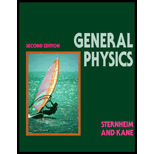
Whether the statement ‘The magnetic field is largest where the field lines are closest.’ is true or false.
Answer to Problem 1RQ
True.
Explanation of Solution
Magnetic fields can be represented using diagrams which are similar to those used for electric fields. The direction of the field is indicated by lines. Closeness of the field lines is proportional to the strength of the field. The field will be weak when the field lines are far way. Similarly, the field will be stronger where the field lines are closer.
Magnetic field lines are always directed from the North Pole to the South Pole outside a magnet. They are continuous loops without a beginning or ending. The direction of the field at a particular point will be tangential to the field line at that point. Two magnetic field lines never intercept each other.
Conclusion:
Thus, the statement ‘the magnetic field is largest where the field lines are closest’ is true.
Want to see more full solutions like this?
Chapter 19 Solutions
General Physics, 2nd Edition
- A 198 kg load is hung on a wire of length of 3.58 m, cross-sectional area 2.00⋅ 10-5 m2, and Young's modulus 8.00⋅10^10 Pa. What is its increase in length?arrow_forwardI. Pushing on a File Cabinet Bob has been asked to push a heavy file cabinet down the hall to another office. It's not on rollers, so there is a lot of friction. At time t = 0 seconds, he starts pushing it from rest with increasing force until it starts to move at t = 2 seconds. He pushes the file cabinet down the hall with varying amounts of force. The velocity versus time graph of the cabinet is shown below. A. On the graphs provided below, 1. draw the net force vs. time that would produce this velocity graph; 2. draw the friction force vs. time for this motion; 3. draw the applied force (Fon Cabinet by Bob) VS. time for this motion (the first two seconds of this graph have been drawn for you). Velocity (m/s) Applied Force (N) Friction Force (N) Net Force (N) A -m B -U time (s) D time (s) time (s) time (s)arrow_forwardanswer itarrow_forward
- Answer everything or don't answer at allarrow_forwardPart A: kg (a) Water at 20 °C (p = 998.3 and v = 1 × 10-6 m²/s) flows through a galvanised m³ iron pipe (k = 0.15 mm) with a diameter of 25 mm, entering the room at point A and discharging at point C from the fully opened gate valve B at a volumetric flow rate of 0.003 m³/s. Determine the required pressure at A, considering all the losses that occur in the system described in Figure Q1. Loss coefficients for pipe fittings have been provided in Table 1. [25 marks] (b) Due to corrosion within the pipe, the average flow velocity at C is observed to be V2 m/s after 10 years of operation whilst the pressure at A remains the same as determined in (a). Determine the average annual rate of growth of k within the pipe. [15 marks] 4₁ Figure Q1. Pipe system Page 2 25 mmarrow_forwardFor an independent study project, you design an experiment to measure the speed of light. You propose to bounce laser light off a mirror that is 53.5 km due east and have it detected by a light sensor that is 119 m due south of the laser. The first problem is to orient the mirror so that the laser light reflects off the mirror and into the light sensor. (a) Determine the angle that the normal to the mirror should make with respect to due west.(b) Since you can read your protractor only so accurately, the mirror is slightly misaligned and the actual angle between the normal to the mirror and due west exceeds the desired amount by 0.003°. Determine how far south you need to move the light sensor in order to detect the reflected laser light.arrow_forward

 Physics for Scientists and Engineers: Foundations...PhysicsISBN:9781133939146Author:Katz, Debora M.Publisher:Cengage Learning
Physics for Scientists and Engineers: Foundations...PhysicsISBN:9781133939146Author:Katz, Debora M.Publisher:Cengage Learning Glencoe Physics: Principles and Problems, Student...PhysicsISBN:9780078807213Author:Paul W. ZitzewitzPublisher:Glencoe/McGraw-Hill
Glencoe Physics: Principles and Problems, Student...PhysicsISBN:9780078807213Author:Paul W. ZitzewitzPublisher:Glencoe/McGraw-Hill College PhysicsPhysicsISBN:9781285737027Author:Raymond A. Serway, Chris VuillePublisher:Cengage Learning
College PhysicsPhysicsISBN:9781285737027Author:Raymond A. Serway, Chris VuillePublisher:Cengage Learning College PhysicsPhysicsISBN:9781305952300Author:Raymond A. Serway, Chris VuillePublisher:Cengage Learning
College PhysicsPhysicsISBN:9781305952300Author:Raymond A. Serway, Chris VuillePublisher:Cengage Learning Principles of Physics: A Calculus-Based TextPhysicsISBN:9781133104261Author:Raymond A. Serway, John W. JewettPublisher:Cengage Learning
Principles of Physics: A Calculus-Based TextPhysicsISBN:9781133104261Author:Raymond A. Serway, John W. JewettPublisher:Cengage Learning





